Fundamentals
4 The Keyboard and the Grand Staff
Chelsey Hamm
Key Takeaways
- Playing the piano will help you in your music theoretical studies, by allowing you to engage kinesthetically with music.
- A pattern of black keys grouped into twos and threes repeats on the piano keyboard for seven octaves.
- The white note C is to the immediate left of the two-note black key pattern, while the white note F is to the immediate left of the three-note black key pattern.
- Piano players, also called pianists, read music on the grand staff.
- Middle C is the note that appears on the line between the two staves in a grand staff.
- When counting notes on a piano keyboard, always count a note to itself as “one.”
Many students find studying music theory easier when they engage with music kinesthetically . In other words, physically creating sounds by playing a musical instrument (such as the piano) helps students to better visualize and audiate the music they are writing down or studying. This allows students to understand the relationship between different pitches more quickly.
The Piano Keyboard
Learning to play notes on the piano is one easy way to engage with music kinesthetically. You may find access to a piano keyboard (acoustic or electronic) at your school, college, or university. You may also purchase a cheap electronic keyboard if you like. Another option is to download a free piano app that you can play on your phone, such as Tiny Piano.
Example 1 shows a photograph of a small portion of a piano keyboard:
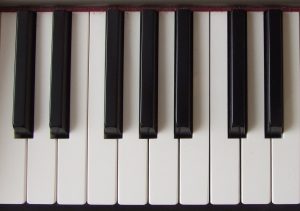
Notice that the keyboard has both white keys and black keys. The black keys are grouped into sets of either three keys or two keys. Example 2 shows a larger portion of a piano keyboard:
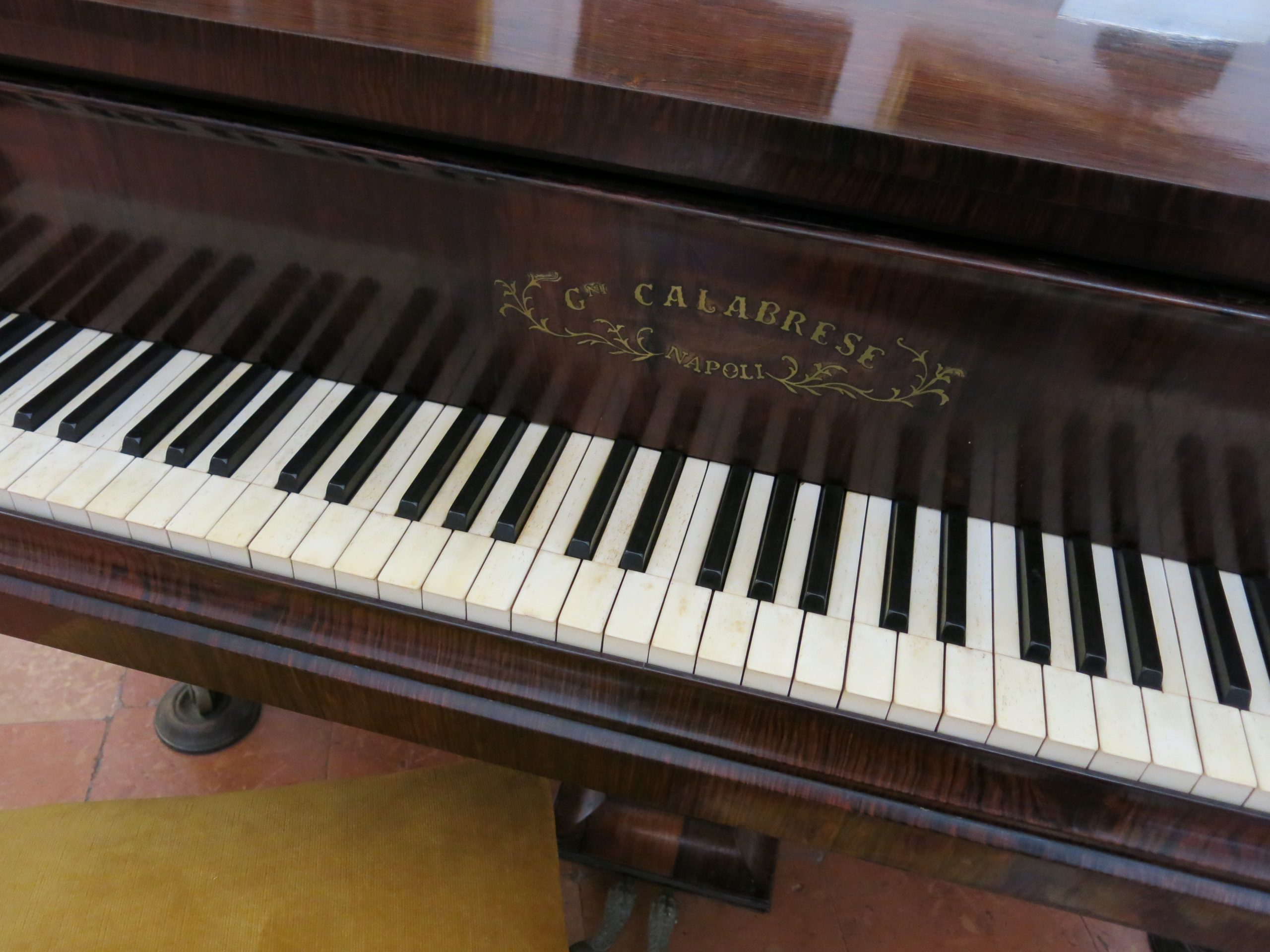
Notice that the sets of three and two black keys alternate throughout the entire length of a piano keyboard. These patterns separate the keys into different octaves.
Playing the Piano
When you sit at the piano, it is important to sit up straight, keeping your head over your shoulders, which should be kept down. Your elbows should be a comfortable distance from your body, and your fingers should remain arched (as if you were pulling a library book off of a shelf). Keep your knees and wrists flexible (not stiff), and keep your feet flat on the ground unless you are using the pedals.
Example 3 shows a brief video which explains how to achieve proper posture at the piano:
Example 3. Dr. Benjamin Corbin (Christopher Newport University) demonstrates proper piano posture.
White Key Letter Names of the Piano Keyboard and Octave Equivalence
Example 4 shows a piano keyboard with the letter names of the white key pitches labeled:

When the black keys appear as a set of two, the note to their immediate left is C. When black keys appear as a set of three, the note to their immediate left is F. As was discussed in the previous chapter, pitches in Western musical notation are designated by the first seven letters of the Latin alphabet: A, B, C, D, E, F, and G. After G these letter names repeat again, beginning with A, creating a loop: A, B, C, D, E, F, G, A, B, C, D, E, F, G, A, B, C, etc. As mentioned in the prior chapter, this loop of letter names exists because musicians and music theorists today accept octave equivalence. In other words, pitches separated by an octave have the same letter name. For example, in Example 4, there are several different keys with the same letter name of “C”; several other different keys have the same letter name of “A.”
The Grand Staff
Music for the piano is typically written in both the treble and bass clefs on a grand staff. Example 5 shows a grand staff:
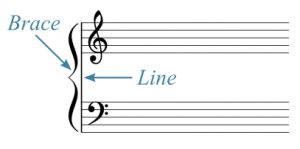
To make a grand staff, a staff with a treble clef is placed above a staff with a bass clef. The two staves are connected on the left side with a line and a brace. Typically, the lower notes (in the bass clef) are played with a pianist’s left hand, while the higher notes (in the treble clef) are played with their right hand.
Example 6 shows the lines and spaces on the grand staff labeled with letter names:
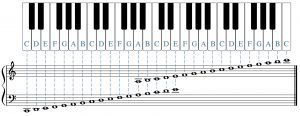
As you can see, the letter names of the lines and spaces of the treble and bass clefs are the same as discussed in the prior chapter (Reading Clefs). Let’s take a closer look at the ledger-line notes that might appear below the treble staff and above the bass clef staff. Example 7 shows some of these notes, labeled with letter names:
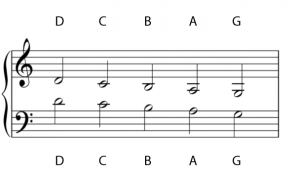
Stems have been placed on the notes in Example 7. The stems that point upwards (those to the right of the noteheads) are meant to be played in the treble clef, while the stems that point downwards (those to the left of the noteheads) are meant to be played in the bass clef. Each of the vertical pairs of notes in Example 7 are the same pitch: i.e. they sound the same, even though they are notated in two different clefs, as indicated by having the same letter name. Example 8 shows the staves of Example 7 vertically condensed:
<img class="wp-image-73 aligncenter" style="font-family: 'Times New Roman', Georgia, 'SBL Greek', serif;font-size: 14pt" src="https://viva.pressbooks.pub/app/uploads/sites/54/2021/08/Screen-Shot-2019-05-30-at-2.03.57-PM-300×94.png" alt="
Example 8. The staves of Example 7 have been vertically condensed and the two notes combined into one (with two stems).
This example shows how these notes would appear if there were not so much space in between the treble clef and bass clef staves of a grand staff. The letter names are the same in Example 8 as they were in Example 7.
Example 9 shows a vertically condensed grand staff with the note C boxed:
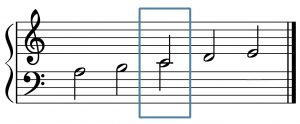
This boxed C is called middle C. Middle C is so named because it would appear in the middle of the treble and bass clef staves if they were vertically condensed (i.e. if there were not so much space in between them), as in Example 9. Additionally, middle C is the note that appears to be around the middle of a piano keyboard, usually underneath the brand’s name.
Example 10 shows Example 9 vertically expanded to its regular spacing:
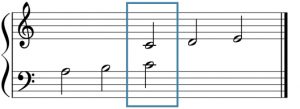
Middle C is still boxed in Example 10. Though it appears in both the treble clef and bass clef staves, this note would sound as the same pitch.
Generic Intervals (Interval Size)
Often in music theory you will want to measure or describe the distance between notes—either on a piano keyboard or a staff. This “count” of notes on a piano keyboard or staff is called a generic interval. When counting generic intervals, it is important to know that when you count a note to itself it should be counted as one and not zero. Example 11 shows two notes, an F and a C, on a staff with a treble clef:
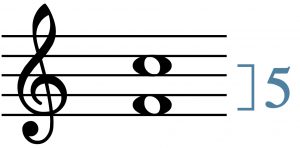
If you count the notes F to C in Example 11 (by counting each line and space between the two notes), you may be tempted to do this: F to G is one; G to A is two; A to B is three; and B to C is four. However, this would be incorrect. Instead, you need to count F to itself as one; F to G as two; G to A as three; A to B as four; and B to C as five. Therefore, we would say that F and C are five notes apart, not four. Music theorists and musicians would call the distance between these two notes a “generic fifth.”
Online Resources
Piano Posture Tips (Liberty Park Music)
Naming White Keys Practice (musictheory.net)
The Grand Staff (musictheory.net)
Grand Staff Note Reading Game (readmusicfree.com)
Generic Intervals (musictheory.net)
Blank Keyboards for Students or Teachers
Drawing the Grand Staff, Identifying Notes (.pdf)
Identifying Notes on the Grand Staff without Accidentals (.pdf, .pdf, .pdf, .pdf, .pdf)
Identifying White Keys on the Piano (.pdf, .pdf)
White Keys on the Piano and the Grand Staff (.pdf, .docx)
The Piano Keyboard and the Grand Staff with Ledger Lines (.pdf, .docx)
Generic Intervals (.pdf, .docx)
Grand Staff Note Names with Ledger Lines (.pdf, .docx)
Relating to movement of parts of the body
Two staves placed one above the other, connected by a brace. The top staff has a treble clef, while the bottom staff has a bass clef.
C4; the C near the middle of the piano keyboard, written on the first ledger line below the treble clef staff or the first ledger line above the bass clef staff
To imagine hearing a sound in one's mind
Two pitches with the same letter name (e.g. "C"), twelve half-steps apart
The assumption that pitches separated by one or more octaves are musically equivalent (e.g. an octave above "A" is "A")
A series of eight notes (such as C to C)
The number of scale steps between notes of a collection or scale

